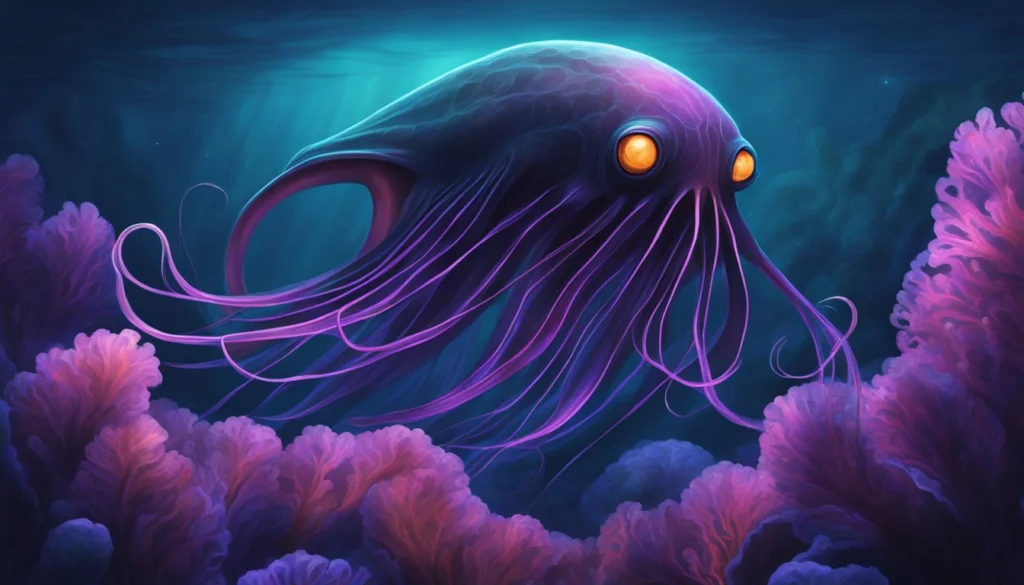Deep in the ocean, where sunlight doesn’t penetrate and the water is cold and dark, lives a creature so strange and otherworldly that it has captivated marine biologists for decades. The Vampire Squid (Vampyroteuthis infernalis) is a unique species that defies many of the expectations we have about squid and octopuses. Despite its fearsome name, the Vampire Squid is not a bloodthirsty predator. Instead, it’s a fascinating example of adaptation to the harsh conditions of the deep sea.
In this article, we’ll explore the secrets of the Vampire Squid, from its unusual appearance and behavior to the adaptations that allow it to thrive in one of the most extreme environments on Earth.
What is the Vampire Squid?
The Vampire Squid is a species of deep-sea cephalopod, closely related to both squids and octopuses. Its scientific name, Vampyroteuthis infernalis, translates to “vampire squid from hell,” a name inspired by its dark, cloak-like webbing and somewhat eerie appearance. However, despite its sinister name, the Vampire Squid is not aggressive. In fact, it’s a passive creature that survives in the deep ocean using specialized adaptations.
1. Appearance
The Vampire Squid’s appearance is perhaps its most striking feature. It has a reddish-brown to black body, depending on its surroundings, and it gets its name from the cape-like webbing that stretches between its arms, which resembles a vampire’s cloak. The squid has large eyes—relative to its body size, they are among the largest in the animal kingdom—that can appear blue or red depending on the lighting. These eyes help it navigate the perpetual darkness of the deep sea.
The squid’s arms are lined with fleshy spines known as cirri, giving it a somewhat fearsome look. However, unlike true squid or octopuses, the Vampire Squid lacks the powerful, suction-cupped tentacles used for grabbing prey. Instead, it has other specialized tools to help it survive.
2. Size
Despite its intimidating name, the Vampire Squid is actually quite small. It typically grows to be about 12 inches (30 cm) long, making it a relatively modest-sized inhabitant of the deep sea. Its compact size allows it to be nimble and efficient in the nutrient-poor environment of the deep ocean.
3. Bioluminescence
One of the most extraordinary features of the Vampire Squid is its ability to produce light through bioluminescence. It has light-producing organs called photophores located on various parts of its body, including the tips of its arms. These photophores allow the Vampire Squid to create a faint glow in the dark depths, which it uses to confuse predators or blend into the surrounding water.
Habitat: The Deep Ocean Abyss
The Vampire Squid lives in the deep sea, specifically in a zone known as the oxygen minimum zone (OMZ), where oxygen levels are extremely low, and light is virtually non-existent. This zone, typically found at depths of 2,000 to 3,000 feet (600 to 900 meters), presents a hostile environment for most animals. However, the Vampire Squid has evolved specialized adaptations that allow it to thrive in these conditions.
1. Low Oxygen Adaptation
Unlike most marine animals that rely on high levels of dissolved oxygen, the Vampire Squid can survive in environments where oxygen levels are as low as 3%. It does this by using hemocyanin, a copper-based molecule in its blood that efficiently binds to oxygen. This allows the Vampire Squid to extract oxygen from the surrounding water, even when it’s in short supply.
Additionally, the Vampire Squid has a very low metabolic rate, meaning it can survive for long periods without expending much energy. This is crucial in the deep sea, where food is scarce and energy must be conserved.
2. Deep Sea Environment
The deep-sea habitat of the Vampire Squid is one of the most extreme environments on Earth. Temperatures are just a few degrees above freezing, and the intense pressure can be more than 100 times greater than at the surface. Few animals are capable of surviving these conditions, but the Vampire Squid is perfectly adapted to this dark, cold world.
Diet: The Passive Feeder
One of the biggest misconceptions about the Vampire Squid is that it’s a fierce predator. In reality, this species is a detritivore, meaning it feeds on marine snow—a mixture of dead plankton, algae, fecal pellets, and other organic matter that drifts down from the upper layers of the ocean.
1. What is Marine Snow?
Marine snow is a continuous shower of tiny organic particles that fall to the ocean floor. This material provides a vital source of nutrients for deep-sea creatures like the Vampire Squid. As marine snow drifts down through the water column, the Vampire Squid uses its specialized feeding strategy to capture and consume this material.
2. Feeding Strategy
The Vampire Squid uses two long, sticky filaments to capture marine snow. These filaments are much longer than its arms and can be extended to sweep through the water, collecting organic particles. Once the filaments are coated with marine snow, the squid retracts them and scrapes the particles off with its cirri-lined arms, delivering the food to its mouth.
This passive feeding strategy allows the Vampire Squid to survive in a low-energy environment where active hunting would be too costly.
Defense Mechanisms: Escaping Predators
Despite its fearsome name, the Vampire Squid is not a predator, nor is it equipped to fight off attackers. Instead, it relies on a combination of bioluminescence and a unique defensive posture to protect itself from predators in the deep sea.
1. Light Displays
When threatened, the Vampire Squid can emit flashes of light from its photophores, a behavior known as bioluminescent displays. These flashes can startle predators or distract them long enough for the squid to make an escape. The squid can also use its photophores to blend into the faint light produced by bioluminescent organisms in the water, effectively becoming invisible in the darkness.
2. “Pineapple” Posture
If flashing lights aren’t enough to deter a predator, the Vampire Squid can also adopt a defensive posture known as the “pineapple” position. In this stance, the squid inverts its webbing, hiding its vulnerable head and body while exposing the spiny cirri on its arms. This makes the squid look larger and more intimidating, potentially scaring off would-be predators.
Unlike octopuses and true squids, the Vampire Squid does not squirt ink when threatened. Instead, it releases a cloud of bioluminescent mucus from its arm tips, which can glow for up to 10 minutes, further confusing its attackers.
Evolutionary Oddity: A Living Fossil
The Vampire Squid is often referred to as a living fossil because it has changed very little over millions of years. It belongs to its own order, Vampyromorphida, which places it between squids and octopuses on the evolutionary tree. This ancient lineage means that the Vampire Squid has been perfectly adapted to its deep-sea environment for a very long time, allowing it to survive with minimal changes over the millennia.
1. An Ancient Lineage
Fossils suggest that the ancestors of the Vampire Squid lived around 300 million years ago, predating many of the species we see today. Its unique combination of traits—such as its arm webbing, photophores, and low-energy lifestyle—makes it one of the most fascinating examples of evolutionary adaptation.
2. Not a True Squid
Despite its name, the Vampire Squid is not a true squid. Instead, it represents a unique evolutionary branch of cephalopods. Its body shape and webbed arms are more similar to octopuses, while its long feeding filaments are distinct from any other cephalopod species. This blend of traits makes the Vampire Squid a true oddity in the marine world.
Fascinating Facts About the Vampire Squid
- World’s Largest Eyes: Relative to its body size, the Vampire Squid has the largest eyes of any animal in the world. This helps it see in the darkness of the deep sea.
- Bioluminescent Mucus: Unlike many cephalopods, which release ink to deter predators, the Vampire Squid produces glowing mucus that can disorient attackers.
- Living Fossil: The Vampire Squid has remained largely unchanged for millions of years, making it a living relic of a much older marine world.
- Low Metabolism: The Vampire Squid has an incredibly low metabolic rate, allowing it to survive in the oxygen-depleted zones of the deep ocean.
- Deep-Sea Dweller: The Vampire Squid lives at depths of up to 3,000 feet (900 meters), in the oxygen minimum zone, where few other creatures can survive.
Conclusion
The Vampire Squid is one of the ocean’s most mysterious and fascinating creatures. Far from being a fearsome predator, it is a gentle detritivore that uses its specialized adaptations to survive in the extreme conditions of the deep sea. From its bioluminescent displays to its ancient evolutionary history, the Vampire Squid continues to captivate scientists and marine enthusiasts alike.
As we continue to explore the deep ocean, we are sure to uncover even more secrets about this remarkable species and the unique ecosystem it calls home.
FAQs
Is the Vampire Squid dangerous to humans?
No, the Vampire Squid is not dangerous to humans. It is a passive feeder that lives deep in the ocean, far from human activity.
What does the Vampire Squid eat?
The Vampire Squid feeds on marine snow, which consists of organic particles like dead plankton, algae, and other debris that fall from the upper layers of the ocean.
How deep does the Vampire Squid live?
The Vampire Squid lives at depths of around 2,000 to 3,000 feet (600 to 900 meters), in a region known as the oxygen minimum zone.
Does the Vampire Squid have predators?
Yes, the Vampire Squid faces predators such as larger fish and deep-sea organisms. However, it uses bioluminescence and defensive postures to protect itself.
Why is the Vampire Squid called a “living fossil”?
The Vampire Squid is considered a living fossil because it has changed very little over millions of years, retaining many traits from its ancient ancestors.

